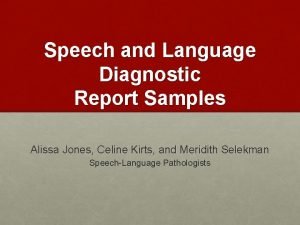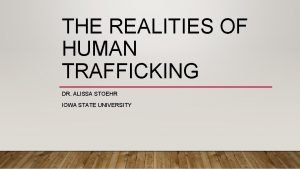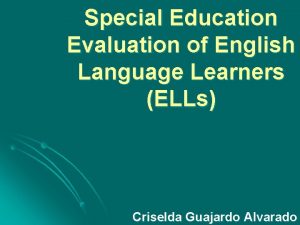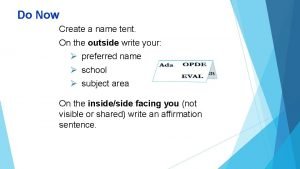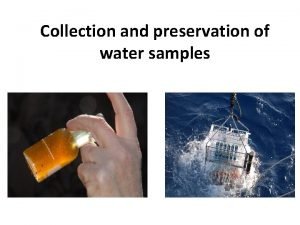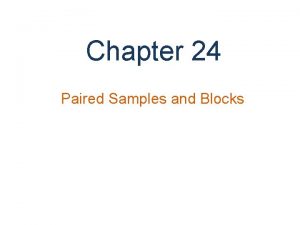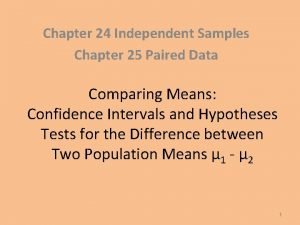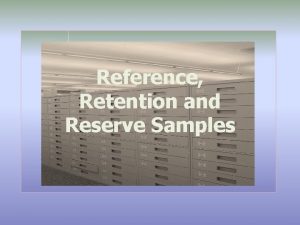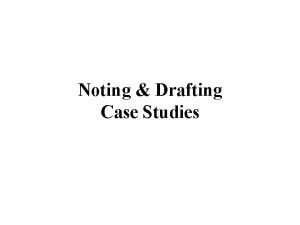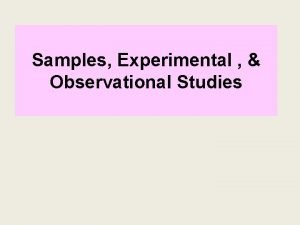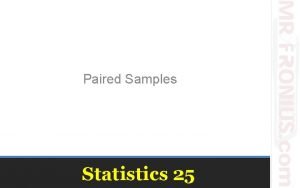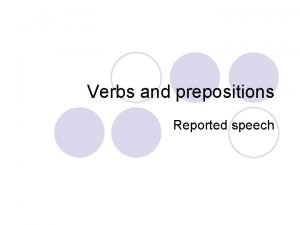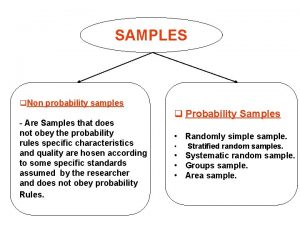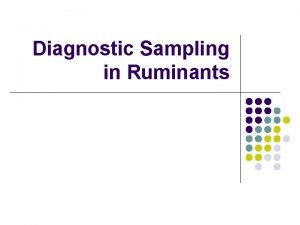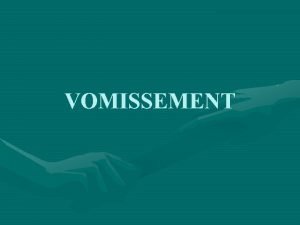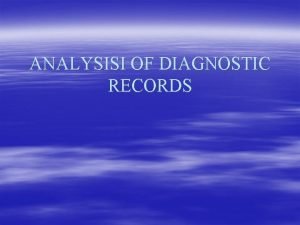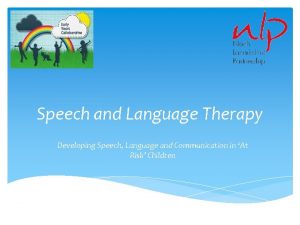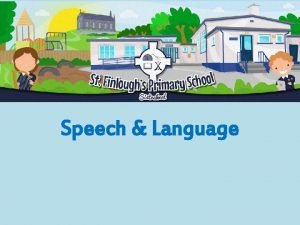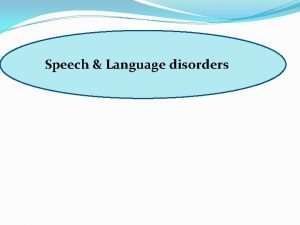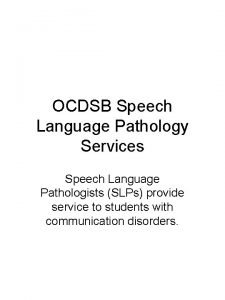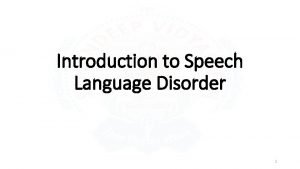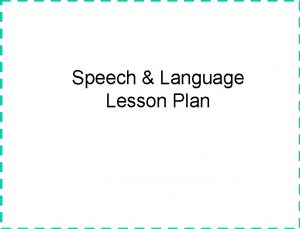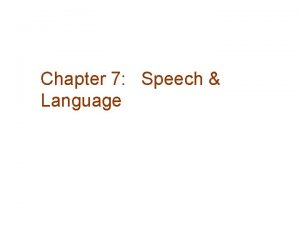Speech and Language Diagnostic Report Samples Alissa Jones

















- Slides: 17

Speech and Language Diagnostic Report Samples Alissa Jones, Celine Kirts, and Meridith Selekman Speech-Language Pathologists

Wh. At do school-based Speech/Language Pathologists do? u. According to ASHA’s Professional Issues Statement (2010), “school-based Speech-Language Pathologists (SLP’s) help students meet the performance standards of a particular school district and state. ” u. SLP’s have integral roles in education. Their primary responsibilities include: v Prevention v Assessment v Intervention v Program design v Data collection/analysis v Compliance

School-based SLP Roles and Responsibilities “SLP’s must determine how students’ academic strengths and weaknesses relate to speech, language, and communication disorders. To do this, SLP’s collect relevant student data in various contexts, develop intervention plans, and provide services in collaboration with others to meet students’ educational needs. ” American Speech-Language-Hearing Association. (2010). Roles and responsibilities of speech-language pathologists in schools [Professional Issues Statement]. Available from www. asha. org/policy.

School-based SLP Roles and Responsibilities u. SLP’s work across all levels. These include: early intervention, Kindergarten, elementary, middle, junior high, and high schools. u. They serve the full range of communication disorders including those involving language, articulation, fluency, voice/resonance, and swallowing. u. SLP’s work with students whose disorders have a significant impact on their educational progress.

School-based SLP roles and responsibilities u. SLP’s highlight language and literacy. Current research supports the interrelationships between the language processes of listening, speaking, reading, and writing. u. SLP’s, like all educators, are accountable for student outcomes. Therefore, they are focused on gathering and interpreting data, evaluating growth and complying with federal and state mandates.

ONE SLP Role/Responsibility: Assessment According to ASHA, “Speech-language assessment is a complex process. Assessing, describing, and interpreting an individual’s communication ability requires the integration of a variety of information gathered in the evaluation process. ASHA’s Preferred Practice Patterns for the Professions of Speech. Language Pathology (2004) indicates that comprehensive speech-language pathology assessment includes several components. ” One of these components is the selection of standardized measures for speech, language, and cognitive communication.

ONE SLP role/Responsibility: Assessment u. Purpose of this project: To develop a useful assessment resource for therapists that would lessen the amount of groundwork a therapist would have to do when writing a diagnostic report. u. Intention: This fund of diagnostic report samples is meant to: v assist with test interpretation leading to therapy based on best practices v allow for the relevant application of test results v give therapists more time to spend planning a wellthought out therapy program for students.

One SLP Role/Responsibility: Assessment u. What does it consist of? v. A concise, yet thorough, explanation of selected tests, and subtests, that can be used in an evaluation report. v. A format to report scores in an organized manner including assessment descriptors and sample writeups. v. A comprehensive list of evaluation materials to assist therapists in selecting an appropriate assessment for specific students.

SLP’s Scope of Practice u. SLP’s assess students’ skills within the following areas: v Language (Receptive, Expressive, Social) v Articulation v Fluency v Voice/Resonance v Swallowing u. Tests for this project were selected based on the most common referral questions received by the authors who work at an elementary level.

Language TESTs u Clinical Evaluation of Language Fundamentals, Fourth Edition (CELF-4) Age Range: 5 -21 years Administration time: 30 -60 minutes u Test of Language Development, Fourth Edition (TOLD-4) Age Range: 4 -8: 11 years Administration time: 60 minutes

Language Tests u. Receptive One Word Picture Vocabulary Test (RWOPVT) Age Range: 2 -80 years Administration Time: 15 -20 minutes u Expressive One Word Picture Vocabulary Test (EOWPVT) Age Range: 2 -80 years Administration Time: 15 -20 minutes

Language Tests u. Clinical Assessment of Spoken Language (CASL) Age Range: 3 -21 years Administration Time: 30 -45 minutes u. Oral and Written Language Scales (OWLS) Age Range: 3 -21: 11 for LC/OE 5 -21: 11 for WE Administration Time: 10 -30 minutes

Social Language Test u. Social Language Development Test (SLDT) Age Range: 6 -11 years Administration Time: 45 minutes

Articulation Tests u Goldman Fristoe Test of Articulation, Second Edition (GFTA-2) Age Range: 2 -21: 11 years Administration Time: 5 -15 minutes u Diagnostic Evaluation of Articulation and Phonology (DEAP) Age Range: 3 -8 years Administration Time: 10 -15 minutes for Artic/Phonology 5 minutes for Oral Motor

Fluency Test u Stuttering Severity Instrument, Third Edition (SSI-3) Age Range: 2 -10 years Administration Time: 10 -20 minutes

References American Speech-Language-Hearing Association. (2010). Roles and responsibilities of speech-language pathologists in schools [Professional Issues Statement]. Available from www. asha. org/policy. American Speech-Language-Hearing Association. (2004). Preferred Practice Patterns for the Professions of Speech-Language Pathology [Professional Issues Statement]. Available from www. asha. org/policy.

THANK You!
 Sample diagnostic report for speech-language pathology
Sample diagnostic report for speech-language pathology Autoplágio o que é
Autoplágio o que é Alissa stoehr iowa state
Alissa stoehr iowa state Alissa pencer
Alissa pencer Alissa kolomiets
Alissa kolomiets Language samples
Language samples Difference between progress report and status report
Difference between progress report and status report Dpgt reflection and outcome samples
Dpgt reflection and outcome samples Types of water sample
Types of water sample Chapter 24 paired samples and blocks
Chapter 24 paired samples and blocks Chapter 24 paired samples and blocks
Chapter 24 paired samples and blocks Reserve sample definition
Reserve sample definition Noting and drafting samples
Noting and drafting samples Biased and unbiased samples
Biased and unbiased samples Surveys, experiments, and observational studies worksheet
Surveys, experiments, and observational studies worksheet Chapter 25 paired samples and blocks
Chapter 25 paired samples and blocks Match the verbs with the prepositions
Match the verbs with the prepositions Pure speech and symbolic speech
Pure speech and symbolic speech
